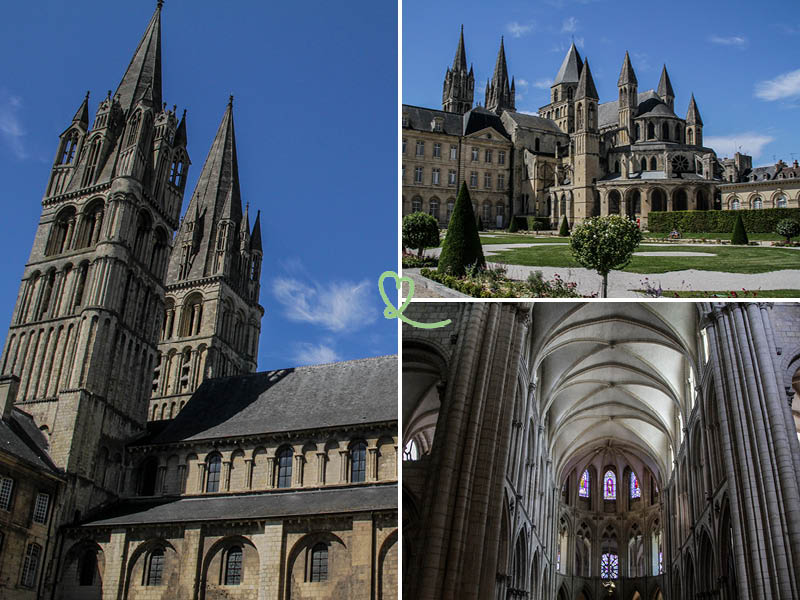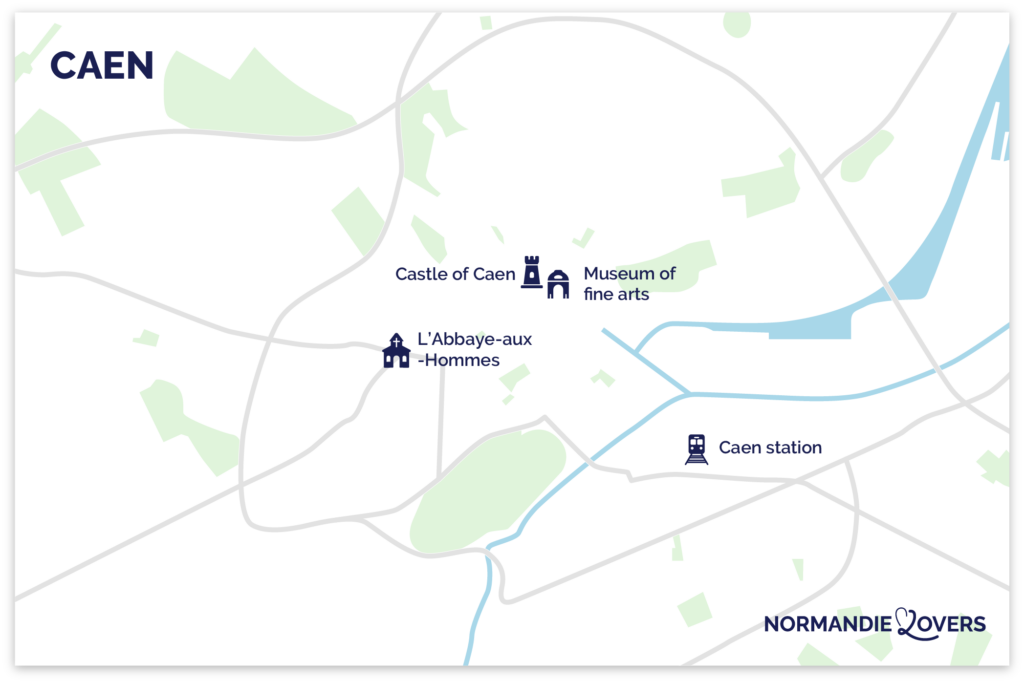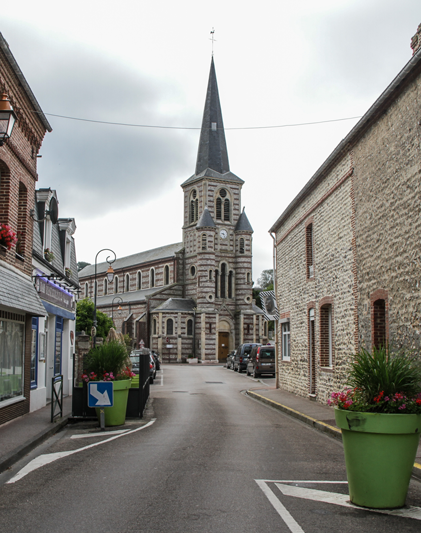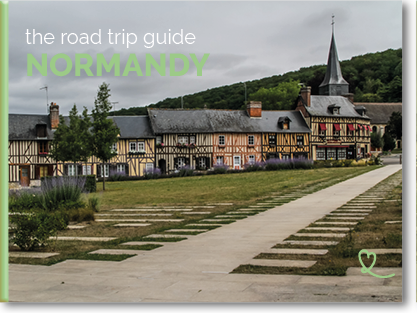Are you passing through Caen? Take the opportunity to visit the Abbaye-aux-Hommes. This Benedictine abbey was founded in 1063 by William the Conqueror and consecrated in 1077. The abbey church houses the tomb of this famous Duke of Normandy and King of England. You can also explore the monastic buildings: around a superb Tuscan-style cloister, you’ll stroll through halls now partly occupied by the Town Hall!
In this article, we present the Abbaye-aux-Hommes in detail, so that this emblematic Caen monument will no longer hold any secrets for you!

This review is completely independent, we visited anonymously and paid our admission in full.
Why visit the Abbaye-aux-Hommes in Caen?
Is the abbey worth a visit?
Yes, we’re convinced! The monastic complex next to the Town Hall left us speechless. We’ve listed it in our article on the best things to do in Caen. We also found it very interesting to visit such an important place for the people of Caen: the abbey is the seat of the town hall, and was also a secondary school for many years.

Why is Abbaye-aux-Hommes famous?
The abbey is famous for its abbey church, home to the tomb of William the Conqueror. It is also known as the male counterpart to the Abbaye-aux-Dames, built at the same time north of Caen. Behind these buildings lies the story of William the Conqueror’s love affair with his cousin, whom he married in 1050 despite papal opposition. The couple obtained a pardon from Pope Nicholas II in 1059, but each had to build an abbey.

What we liked best
Our visit was a real “coup de coeur”. Here they are:
- L’Esplanade Jean-Marie-Louvel: we found the panorama of the imposing town hall, its French garden and the abbey impressive and unique!
- The cloister: in our opinion, this Tuscan-style cloister, emblematic of monastic life, is magnificent!
- The chapter house: this room is our favorite of the tour: it’s rare to have the chance to visit a town hall wedding hall without being one of the guests!

Subscribe to our Newsletter
- Get away from it all with Region Lovers’ beautiful destinations!
- Once a month
- Advertising-free
Practical tips and map: Abbaye-aux-Hommes, Caen, France.
Where is the abbey?
The Abbaye-aux-Hommes is located on the Esplanade Jean-Marie Louvel, in Caen (14027) in the Calvados department, Normandy.

- Driving time from Rouen: 1h30min.
- Driving time from Evreux: 1h45min.
- Driving time from Alençon: 1h25min.
- Driving time from Cherbourg: 1h30min.
- Driving time from Mont-Saint-Michel: 1h30min.
How to get there
We recommend driving to Caen if you also want to visit the rest of Normandy without time constraints. Otherwise, it’s best to go by train. Caen’s ring roads are particularly congested at peak times, as is the historic center, which can be difficult to navigate.
See available timetables and book your train and coach tickets now.
Regular TER lines serve Caen from Paris Saint-Lazare, as well as from Le Mans and Rennes.
The abbey can be reached from the station in around 30 minutes on foot and 20 minutes by public transport.

You can take the bus routes:
- Nomad 107, 115, or 116: Lycée Malherbe stop.
- Lines 1 or 3: Hôtel de Ville stop, platform 2.
- Lines 6A or 11: Hôtel de Ville stop, platform 3.
If you prefer the streetcar, you can take line 1 or 3 and get off at the “Château Quatrans” stop.
To plan your route, visit the official Caen transport network website here.
Finally, you can also opt for a bicycle. A self-service bike station is located right next to the abbey (26 Place de l’Ancienne Boucherie). To find out more, click here.

Parking
The abbey does not have a dedicated parking lot for visitors. You can, however, park easily in these nearby parking lots:
- Parking Guillouard: outdoor public pay parking lot with public toilets.
- Parking Indigo Caen Hôtel de Ville : paid underground parking lot, open 24/24h.
OUR ADVICE FOR RENTING A CAR IN Normandy
- Compare prices on our preferred platform: DiscoverCars – one of the best rated sites.
- Choose a car that is comfortable enough (distances can be long) but compact (some parking lots and villages are narrow).
- Think of thecomplete insurance (some roads are tortuous and narrow).
- There is a lot of demand, book it early.

Schedules and rates
Abbaye-aux-Hommes is open all year round:
- October 02 to April 02: Monday to Thursday 8am to 6pm, Friday 8am to 5pm, Saturdays, Sundays during school vacations and public holidays 9am to 1pm and 2pm to 5:30pm.
- April 3 to May 30: Monday to Thursday 8am to 6pm, Friday 8am to 5pm, weekends and public holidays 9:30am to 1pm and 2pm to 6pm.
- June1 to October 1: Monday to Friday 8am to 7pm, weekends and public holidays 9:30am to 7pm.
- Closed December 25, January 1, January weekends and May 1.
The ticket office closes 30min before the closing of the spaces.
Here are the prices:
- Adult admission (during temporary exhibitions): €5
- Adult admission (excluding temporary exhibitions): €3
- Free: under 18s, jobseekers, Caen residents…
To see the full list of free beneficiaries, visit the official website here.
This visit is included in the city’s City Pass , which offers discounts for a period of 24 to 72 hours (restaurants, shops, leisure sites, Caen’s cultural sites…).

If you prefer guided tours, choose a city tour with a local guide: Caen’s heritage will no longer hold any secrets for you!
Guided tours of the abbey’s prestigious sites and its evolution over the centuries are organized from time to time and are available on reservation. We invite you to consult the agenda on the official website here.

Best time to visit the abbey
To take full advantage of the abbey’s peaceful setting, we advise you to visit outside school vacations, if possible, and on weekdays. The peak time is between 2 and 3 pm, so we recommend you go during opening hours or just before closing time.

How long does it take to visit the abbey and what are the main difficulties?
Allow 1h to 1h30 for your visit. This duration varies according to the period of your visit (with or without temporary exhibitions). The abbey doesn’t present many difficulties. The tour is accessible to people with reduced mobility (ramp…). Only the guard room and the wine press, visible only on guided tours, are not accessible.
A number of devices have been designed for the hearing impaired (magnetic loop, tablet with videos in LSF, etc.), the visually impaired (Braille panels, embossed supports, etc.) and the mentally ill (iconographic documentation, etc.). For further information, please contact the abbey reception desk.

Advice on how to visit
We recommend you follow the recommended itinerary, which begins inside the monastic buildings, from the chauffoir to the Scriptorium, via the cloister. To visit St. Stephen’s Church, you’ll need to exit and enter from the chevet side.

The abbey with children
There is no special children’s tour of the abbey. To make your discovery of this monument even more entertaining, we recommend that you opt for a guided tour. The city of Caen is organizing a themed family tour, available by reservation only, entitled “Les Petits Secrets de l’Abbaye-aux-Hommes”. It lets you explore the monument with the help of a game booklet featuring riddles, codes and lots of anecdotes! For more information, see the agenda on the official website here.

DISCOVER Caen
- What to do in Caen
- Where to stay in Caen: our best hotels
- Where to eat in Caen: our best restaurants
- Caen’s best museums
- Itineraries: 1 day – 2 days
- Caen Castle
- Caen Memorial Museum
- Rent a car in Caen: our tips

Nearby restaurants
Caen is a city with many varied and tasty restaurants. Here is a selection of three establishments featured in our article on the best restaurants to eat in Caen:
- La Vraie Vie: this restaurant, a 5-minute walk from the abbey, offers refined cuisine that changes with the seasons, in a friendly atmosphere.
- Restaurant L’Aromate: Axel de Caseneuve and Inès de Saint Jores’ bistronomic table is a real invitation to travel, and we were transported!
- Bar-restaurant Moon & Sons: this subdued pub inspired by the world of Harry Potter offers a 100% plant-based menu (dishes, pastries and snacks).
WHERE TO STAY IN Caen
Option 1: in the old town center
We recommend..:
- Hotel Best Western Plus Le moderne not far from the castle – see prices, photos and availability
- Hotel La Fontaine also near the castle – see prices, photos and availability
- B&B Les Chambres de L’Abbaye, near Abbaye-aux-Hommes – see prices, photos and availability

Option 2: to Ouistreham
To sleep more in the countryside or near the beach (15 to 20min from Rouen). We recommend..:
- Hotel Manoir Hastings and its stone houses – see prices, photos and availability.
- Hotel La Mare Ô Poissons and its swimming pool – see prices, photos and availability

Option 3: near the port or station
We recommend..:
- Campanile hotel next to the station – see prices, photos and availability.

Monastic buildings
The chapter house and boiler room
The tour begins in the monastic buildings. We soon come upon our favorite room, the chapter house. It was an important place when the monks lived in the abbey: they met to make decisions concerning the management of the abbey, confessed their faults, and listened to the reading of a chapter of the Rule of St. Benedict. This rule still governs the lives of Benedictine monks today. First used as a high school chapel, then as a chaplaincy in the early 20th century, this room is now the marriage hall at City Hall!

We then discover an unusual room: “le chauffoir”. The Rule of St. Benedict excludes comfort from the lives of monks. The abbey has no fireplaces, except in this room. The heating room was designed to keep the monks warm in winter.

The cloister
We head for the cloister. The heart of the abbey, it’s also the heart of the visit, as this square courtyard serves the main rooms of the monument. A vaulted gallery surrounds the courtyard. It was built in the 18th century by an abbey monk named Guillaume de la Tremblaye. The sober architecture is in the Tuscan style, with semicircular arches resting on massive columns. We found that this sobriety blended perfectly with the Romanesque nave of the abbey church.

We admired the garden in the center of the cloister. This highly geometric French garden was inspired by Le Nôtre, who designed the gardens at the Château de Versailles. It was installed when the abbey was restored in the 1960s. In the 19th century, it was used as an exercise ground and playground for high school students.

The grand staircase and refectory
The cloister serves the refectory wing. We were stunned by the grand staircase. This suspended staircase, dating from the second half of the 18th century, gave the monks access to their cells, the infirmary and the library. This beautiful staircase features elegant wrought-iron railings and is built according to the “stereotomy” principle: the stones, of different sizes, support the vault by the pressure they exert on each other!

The staircase leads to the largest and richest room on the tour: the refectory. We were surprised by the dimensions of this room (30m long and 9m wide). In fact, in the 18th century, only around thirty monks ate here! This size is explained by the vow of silence, which forbade monks to eat face-to-face. Monks could listen to religious texts and admire the biblical paintings adorning the walls. A refectory and examination room during the lycée era, then a hospital in June and July 1944, the refectory is now a reception room for the town hall.

Before leaving the convent buildings, don’t forget to visit the scriptorium on the first floor, which is the temporary exhibition hall!
USE OUR GUIDE TO PLAN A
DREAM TRIP TO Normandy
All the information you need for your trip:
- 8 maps that make planning easier
- 160+ pre-selected locations
- Practical advice
- 300+ photos to help you choose

Saint-Étienne Church
Typical Norman exterior architecture
Once our tour of the convent buildings was over, we headed outside to get a better look at the church or abbey church of Saint-Etienne. Its exterior architecture is remarkable. Typically Norman, it is the first example of the “Norman harmonic facade”, a facade style that was to dominate churches in the West, such as the Basilica of Saint-Denis. It is composed of 2 symmetrical towers, aligned with the nave’s main door. We were struck by the massive yet uncluttered look of the facade, which rises over 3 levels. Higher up, the church is more ornate, with 2 beautiful 13th-century Gothic spires.

We headed for the chevet where the entrance is located. Dating from the 13th century, it was rebuilt in the 17th century after the collapse of its lantern tower. We noticed its 4 bell towers topped by spires, quite similar to what we had seen at Bayeux Cathedral.

A Romanesque and Gothic interior
We then set off to discover the interior of this beautiful church. We weren’t disappointed, admiring both Gothic and Romanesque elements, particularly in the nave. With a length of 56m, it has 3 levels. The latter, with its high windows, gives the building plenty of light. At this level, a gallery known as the “coursière” leads around the abbey church. Take a closer look at the sexpartite vaults in the nave: dating from the early 12th century, they are reputed to be the oldest cross vaults in France! They have inspired the architecture of many other monuments, such as Durham Cathedral in England.

Make your way through the nave, and don’t forget to look up at the transept crossing! You’ll see a sublime ribbed vault supporting a square lantern tower on two levels.

Furniture, sculptures and the tomb of William the Conqueror
The church’s decoration is quite limited. It is concentrated mainly in the capitals, which were restored in the 17th and 18th centuries. We saw capitals with leaves, others with tracery and finally historiated capitals, featuring dragons influenced by Anglo-Scandinavian examples. They date from the 12th century, as does the choir, at the foot of which is the tomb of William the Conqueror. The 19th-century tombstone is very sober, the original funerary monument having been destroyed over the centuries.

Then it was the organ that caught our eye. We found its 18th-century sideboard very attractive, resting on 2 caryatids. Last but not least, we took a look at some remarkable pieces of furniture, most of which are protected as historic monuments. Don’t miss the clock in the transept!
Subscribe to our Newsletter
- Get away from it all with Region Lovers’ beautiful destinations!
- Once a month
- Advertising-free
History in brief
The Abbaye-aux-Hommes has had an eventful history. It was built following the marriage of William the Conqueror, Duke of Normandy and King of England, to his cousin Matilda of Flanders, which was not approved by the Church. To obtain the pope’s forgiveness, the couple built the Abbaye-aux-Hommes and the Abbaye-aux-Dames respectively, where they chose to be buried. The building of these abbeys also established the duke’s authority over lower Normandy, and made Caen a secondary capital after Rouen. Built between 1065 and 1083, the abbey was dedicated in 1066, the year of William the Conqueror’s coronation. To find out more about this king of England, read our article on visiting the Bayeux Tapestry Museum.

The 2 abbeys almost disappeared during the Hundred Years’ War, particularly the towers on the façade, which the French wanted to destroy to prevent the English from using them to dominate the town. They were preserved after a monk betrayed the abbeys to the enemy. Abbeys were pillaged during the Wars of Religion. In 1566, the lantern tower and choir collapsed.

The 18th century was a period of reconstruction, but also of creation, with the appearance of a new abbey dwelling and the development of the esplanade. During the French Revolution, the abbey was bought by the town, which set up various administrative offices. Under Napoleon I, the abbey became a lycée. In 1944, the abbey was spared by Allied bombing because it was occupied by the Red Cross.

After the war, the buildings and esplanade were restored to accommodate the town hall, which moved in in 1965. Because of this function, certain parts of the abbey, dating from the 14th century, are inaccessible to visitors. These include the Salle des Gardes, where the town council meets, the Ducal Palace, home to the town archives, and the Artothèque, dedicated to contemporary art.
PLAN YOUR TRIP TO Normandy
Inspiration destinations
- Deciding where to go in Normandy – the best destinations
- Our weekend ideas: best-of, romantic, unusual, seaside, luxury, family
- 16 seaside hotels in Normandy
- The most beautiful charming hotels in Normandy

Best of

Practice
- Where to stay in Normandy – best places and hotels
- See our tips for renting a car at CDG airport, Orly airport, Beauvais airport, Caen, Rouen, Bayeux…

Frequently asked questions
Is the Abbaye-aux-Hommes still in operation?
The abbey is no longer occupied by monks, but most of its rooms are used by the town hall.

What’s the difference between Abbaye-aux-Hommes and Abbaye-aux-Dames?
The Abbaye-aux-Hommes was built by William the Conqueror in 1063, southwest of Caen, to be occupied by Benedictine monks. Abbaye-aux-Dames was built on the orders of William the Conqueror’s wife and cousin, Matilda of Flanders. Located north of Caen, it was home to nuns. The creation of these 2 abbeys enabled the couple to obtain forgiveness from the papacy, which had forbidden their marriage because of their relationship!

Are there any special events or celebrations taking place at Abbaye-aux-Hommes?
Caen town hall regularly occupies certain rooms in the abbey that are open to visitors, such as the refectory, which is a reception hall, and the chapter house, which is also the town’s wedding hall. The scriptorium is a room dedicated to temporary exhibitions. To find out more about the program, consult the agenda on the official website here.
All our tips in this article were put into words with the help of Fanny.



